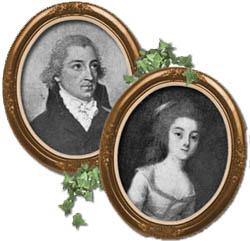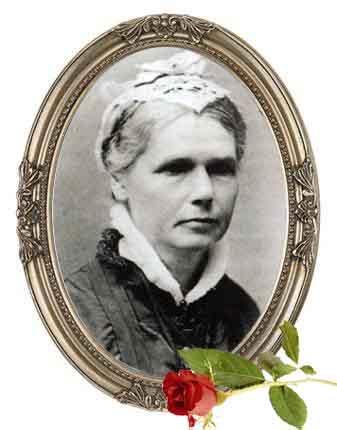The Rice Portrait
In the gallery there were many family portraits, but they could have little to fix the attention of a stranger. Elizabeth walked on in quest of the only face whose features would be known to her. -Pride and Prejudice
For years there has been (some say, unnecessary) controversy over a charming portrait of an unnamed girl in white- clearly she is a member of the Austen family…but is she THE Austen we all so want her to be? With few known likenesses of Jane Austen to compare this too, it seems reasonable to accept the word of family members who knew Jane Austen—yet there are those—costume historians, authors, and even the head of the National Portrait Gallery (though his predecessors believed it to be authentic) who refuse to accept the “Rice Portrait” as it is called, as a genuine article.
The current owners of the portrait, the Rice Family, descendants of Jane’s brother Francis, firmly believe the portrait to be genuine and have spent the last several years tracing the history (provenance) of this portrait, discovering, along the way, clues that would surely have sent Sherlock Holmes hard fast on the trail of this mystery. Here, in her own words, is the history of the Rice Portrait, by it’s owner, Anne Rice: This story, and the portrait of Jane Austen started in the summer of 1788 when George Austen took his wife, and his two young daughters, Cassandra, aged 15, and Jane aged not quite 13 years old to visit their Great Uncle Francis at his him called The Red House in Sevenoaks, Kent. Francis Austen was an enormously rich and successful man, he had been head of Lincoln’s Inn in London, and owned properties in Essex, as well as in Kent. He was an expert in the settling, and safeguarding of large estates by entail, and by inheritance, and counted some of the most important families in England amongst his clients; the Dorsets, the Berkeleys, and Cravens, amongst others.
 In 1788, he was 90 years old, having been born in 1698 during the reign of William III. His second wife Jane had been Jane Austen’s godmother, but was now dead, and Francis was indulging himself in his old age as a benevolent family patriarch. Ozais Humphrey, much patronized by Francis’ main employer and patron, the Duke of Dorset, had already painted him twice; once at the Duke’s request, and again at his own request for The Red House. Francis had always been a kind and generous patron of his nephew George Austen. It is hardly surprising that he was persuaded, or perhaps cajoled, into commissioning portraits of his two great nieces from his friend Ozias, who was rather down on his luck at the time, having returned from India in the spring of 1788, with little success and somewhat short of money. Ozias always demanded half of his fee for his portraits “up front”. His accounts show that he charged about 13 guineas first, and the second half on completion. He made a note of Francis Austen’s death in 1791, which implies money owing to him.
In 1788, he was 90 years old, having been born in 1698 during the reign of William III. His second wife Jane had been Jane Austen’s godmother, but was now dead, and Francis was indulging himself in his old age as a benevolent family patriarch. Ozais Humphrey, much patronized by Francis’ main employer and patron, the Duke of Dorset, had already painted him twice; once at the Duke’s request, and again at his own request for The Red House. Francis had always been a kind and generous patron of his nephew George Austen. It is hardly surprising that he was persuaded, or perhaps cajoled, into commissioning portraits of his two great nieces from his friend Ozias, who was rather down on his luck at the time, having returned from India in the spring of 1788, with little success and somewhat short of money. Ozias always demanded half of his fee for his portraits “up front”. His accounts show that he charged about 13 guineas first, and the second half on completion. He made a note of Francis Austen’s death in 1791, which implies money owing to him.
The family has always believe that after the portraits of Jane and Cassandra were commissioned in the summer of 1788, Ozias Humphrey stayed at Godmersham Park that autumn, and there executed sketches and drawings of the backgrounds of the park. On the 7th of October that year, Edward Austen-Knight was 21 years old, and again, family tradition has it that he returned from the first leg of his Grand Tour for his Coming of Age celebrations with his adoptive parents. His own portrait, also signed OH, places him within the Godmersham grounds in front of a large English oak tree, with the old temple ruins in the background, along with graves from the Godmersham churchyard.  Jane’s background includes the river Stour that flows to the left of the big house, and in both pictures the same autumnal colors are used, as well as the depiction of stormy skies. It’s interesting to note the stance in both of the portraits, the angles of the cane and parasol are almost identical. Ozias having been trained as a miniaturist and a very fine one, had difficulty in many of his paintings in the execution of limbs painted in large. Note the elongation of Edward’s arm holding his hat and Jane’s elongated arm holding the parasol.
Jane’s background includes the river Stour that flows to the left of the big house, and in both pictures the same autumnal colors are used, as well as the depiction of stormy skies. It’s interesting to note the stance in both of the portraits, the angles of the cane and parasol are almost identical. Ozias having been trained as a miniaturist and a very fine one, had difficulty in many of his paintings in the execution of limbs painted in large. Note the elongation of Edward’s arm holding his hat and Jane’s elongated arm holding the parasol.
As with much of the inherited Austen artifacts and documents, over time they were split amongst the family members. The last descendant of the Kippington Austen line may well have owned the portrait of Cassandra. May Harrison lived out her final years in Grasse, France and on November 28, 1952, she wrote to R. W. Chapman saying she owned by descent, a portrait which she believed could be Jane Austen. Mrs. Harrison’s nephew remembers her possessing a painting of a girl dressed in white, but it was not always hung as she rotated her pictures. No one seems to have considered that this could have been the portrait of Cassandra. As was the usual custom, Ozias would have finished the portraits in his London studio, and kept them until he received payment for the second tranche of the paintings. Thomas Knight is believed to have commissioned Edward’s portrait (Ozias certainly copied the Romney portrait of his wife, Catherine Knight, for him. It is a small, oval miniature that he could carry with him.) Uncle Francis died in 1791, and the two portraits were inherited by his eldest son, Francis Motley Austen, the second owner of the portrait...
The rest of this story can be found at www.janeaustenriceportrait.co.uk.




Leave a comment
This site is protected by hCaptcha and the hCaptcha Privacy Policy and Terms of Service apply.